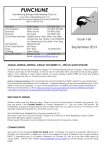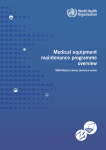Download Your role in the care
Transcript
Feature 43 EMERGENCY The Stryker Power-PRO XT powered ambulance cot. Your role in the care & service of ambulance equipment Most equipment on an ambulance should get serviced every six or 12 months, but the reality is that equipment are not looked after properly, and the threat of cheap imports flooding the market and break-away technicians doing services at a fraction of the real price, do not make for a better environment. You might make your budget now, but at what price? By: Ilze Kubirske - Senior Writer The equipment on an ambulance are often taken into rugged conditions and need repairing more often than their counterparts at hospitals. We have a look at the movement of the equipment from an incident to the manufacturer, and back. The service According to Markus Marais from Phillips, their most popular life support model is the Heartstart XL. “The users are supposed to do a shift-check at their start of their shift that includes the battery, ECG etc. The machines will prompt the user to check certain parts of the machine and will either give a ‘pass’ or ‘fail’, if one of the tests failed, it is an early warning that you should bring it in for service. They don’t have a manual mode and it has a checklist that it goes through on every startup to check that it works fine.” should be inspected every six or 12 months by a service or clinical engineer that goes through visual checks: • damage to the machine • connectors broken, • screen malfunction • ECG check, • output energy performance through a calibrated testing device • seconds the device takes from activation of selected Joules to readiness to deliver the energy. • expiry date indicated on the battery pack • external charging equipment, • internal pressure and that • all buttons functions, • software update if required “A service takes about an hour and it has to be booked ahead of time.“With the bigger customers we have a service agreement and will provide a backup device if there is a breakdown, but they should in general be able to cope without the device for a morning or so,” said Marais. Freddie Gouws, Clinical technician at Mediclinic, said that their defibrillators are checked on a four-weekly, six-monthly (26 weekly) battery capacity check, and a six-monthly service as per manufacturer recommendations, incorporated into company policy.” Carel Groenewald, director of Carmica Medical distributors said that the device Your role. Take care Marais said that awareness is key in taking Life support Life support machines is something you simply can’t compromise on, as you very well know. These are some of the most vital equipment on an ambulance and although defibrillators are placed in a carry bag to protect them, it is still hospital equipment and the usual wear and tear out in the field will often lead to repairs before it is due for a service. proper care of ambulance equipment as the patient deserves the best care and equipment in working order. “These are not diagnostic equipment like x-ray machines, if your heart stop you have minutes and we all know how important those are in saving a life, you can go without some of the other equipment, but life support you simply don’t mess with. It is the responsibility of the paramedic and the team leader to make sure that the equipment are looked after.” “The nature of the repairs would be parts like the battery, ECG cable, paddles. The device should be serviced every six months, where Phillips will assess it and if it passes the normal tests they will do a performance assurance that includes safety analysis, electrical safety as well as the output energies.” Ryan Cowan from Trojan Medical also gives advice on checking their Lucas 2 (Automated Chest Compression Unit) and note that they hold the national tender for the LIFEPAK 1000 . “The batteries level gauge should be checked regularly, as well as the electrodes expiration dates on a monthly basis , most automated machines will also indicate if something is wrong , should this happen,the paramedic is advised to report it to the technical department who will in turn liaise with us to have the equipment analysed.” CONTINUED >>> FIRE AFRICA l March/April 2014 Feature <<<CONTINUED EMERGENCY 44 Keep the papers “We provide the customers with a performance assurance certificate after a service and these are often just thrown away, there should be more regulations or quality management when it comes to this as this piece of paper is vital if a machine breaks or malfunctions,” said Marais. “We often lose track of the devices. We would sell it to a company and the fly-by-nights will sell devices to smaller companies and not give feedback, not knowing the implications. The only way to correct this is through regulations. The act has been reviewed several times and there is a clause that all medical devices should be traceable, but it doesn’t stipulate how this is to be done.” “The fly-by-nights are a big problem in the industry as they put cheap products on the market, just to disappear in six months’ time, leaving the buyer with no follow-up service or parts. The buyer bought a bargain yes, but it will cost him more in the long run since the device has to be replaced by a local product that would have been the best option from the word go,” said Groenewald. Stretchers After life support, the failure of a stretcher can have the worst impact on you company, the patient, and your reputation. The service The basic service should include: • Checking of the IV pole, • Checking the mattress for tares, • Checking the side rails lock properly, • Checking movement of the bed, • Checking that the bed locks into position, • Checking the condition of the wheels and brakes, • Checking hydraulic piston, • A structural check. This takes about 5 to 10 min if nothing major is wrong. The service According to Gerhard Eloff from Stryker South Africa the servicing of ambulance stretchers need to occur as per manufacturer specifications. This together with the service and inspection procedure of the stretchers are generally listed in the product manuals of each supplier. Maintenance that can be improved on by the users would be: washing the stretcher FIRE AFRICA l March/April 2014 with the correct disinfectants often, a regular visual inspection will also mean that the stretcher will be brought to get fixed before a patient lies on the floor. “A lot of times the smaller ambulance companies would import stretchers without getting it tested or improved, and the self-loaders would give way with the patient on it. The bigger companies insist of quality equipment and make sure that it complies with the OshAct 85/1993,” said Groenewald. “The tried and tested, imported brands are the safe options, but they are just as expensive as they are safe. Locally we have good quality products that contributes to our economy, is SABS tested and build by South Africans for South African conditions. The local product can also be up to R15 000 cheaper than its counterpart from Italy or the US. The maintenance and availability of parts, as well as the maintenance and service is much cheaper, it is the safer option for the patient as well as the company,” said Groenewald. Suppliers of the stretchers should in general keep stock on hand of the parts that require frequent replacement in order to keep the downtime of the ambulances as low as possible. Take care If the stretchers were not serviced it would be more difficult to lift the bed into the ambulance, or the breaks on the bed will fail and it can be detrimental to the patient and the user. If the bed is over-used, used on rugged terrain, or a very heavy patient is placed on one stretcher, the wheels will break. The limit is 300kg, and in this case two stretchers should be strapped together to accommodate the extra weight. If the service is skipped the hydraulic piston can collapse and if the patient has a spinal injury the consequences and legal implications for the paramedic as well as the company can be quite detrimental. In order to prolong the service life of the stretchers, users should adhere to the user instructions and user limitations as set out the product manuals. This is vital for patient safety as the incorrect use of the stretchers could result in the stretchers failing leading to further patient injury. Technical aspects In order for the service process to be managed properly, you need a “bridge” between product originators and endusers, by combining the perspectives of being both close to the point-ofuse (“front lines”), while also trained in product and process design. The association of clinical engineers forms this link in the industry. The role of a clinical engineer include training and supervising biomedical equipment technicians (BMETs) in charge of the servicing, and he is in charge of all clinical equipment (in a hospital or ambulance). According to Paulo Boschetti, clinical engineer at Dräger and member of the Clinical Engineering Association of South Africa (CEASA), the new regulation that is still being promulgated will require all people that works with medical equipment to be registered, a problem that they at the association intend to addressed quickly. “You can’t exclude a person with 30 years’ experience because he has no qualification, they are masters of their trade. To overcome this you can register as a clinical engineering technician or as a medical equipment maintainer, this is a SAQA qualification. “We comply to 9001 ISO 13485, the maintenance and repair of equipment post-sale. As international companies we have to adhere to European standards as well, they will do an audit and check services records and standards. Suppliers should have a service technician with a B tech degree or a diploma. But when he walks in at our company, he doesn’t know our equipment, and teaching him and getting him certified takes about a year,” said Boschetti. “The company itself is in charge of booking a service in advanced, we will give them a quote, and they take it from there and decide to do the service or not. There are those entities that don’t get the equipment serviced, they will lose their warranty, said David Joubert, national service manager at Medhold. Some technicians would break away and still operate under their old company’s name and would charge three times the amount for a service. “These fly-by-nights Feature 45 EMERGENCY The Phillips Heartstart XL is one of the company’s most popular defibrillators. often try and source parts from us, and we don’t give it to them, so they would ‘service’ by dusting off the machines and not doing a proper service and don’t have the expensive testing machines, the latest updates or software. They put a sticker on, and it is ‘serviced’,” said Joubert. Trojan supplies the Lifepak 1000. “The bigger companies like Netcare, ER24, Life, Mediclinic, and their engineers know how equipment should be serviced, the costs of parts and repairs, and the cost of replacement. And the technicians authorised to perform work on their premises by supplier companies. This is policy,” said Freddie Gouws, clinical technician at Mediclinic. “The smaller companies might go for a cheap service where no parts are replaced, and they get the sticker, but in the long run the equipment will break and it will cost more than a proper service would have cost them,” said Joubert. How often should you check your AED? Example of maintenance on a Lifepak 1000 as supplied by Trojan Medical. • Check the readiness display to determine the level of battery charge and that the OK symbol is visible. Check the Use By date on the therapy electrode packet. Check other emergency supplies that may be stored with the defibrillator. A good rule of thumb is to inspect the • device at least once a month to ensure it is in working condition. However, you should • always refer to the product’s user manual for the manufactures specifications. If the OK symbol is not visible, the level of Pad expiration battery charge is low, or the electrode Use AED pads have a perishable life. Check the By date has passed,the defibrillator needs expiration date on your pads, it is often attention. Replace the battery and the found on the front of the package in bold electrode packet, or call your authorized letters. service personnel. Software updates Occasionally manufacturers will release software updates for AEDs in the field. These updates can be done on-site with the right technology. In many instances, you can connect the defibrillator to a computer and upload the software update. When establishing your local inspection schedule, consider how often the defibrillator will be used and how familiar the operators are with using a defibrillator. For example, if the defibrillator is used rarely, weekly inspections are appropriate. Maintenance On a regular basis, you should do the following: Inspection • Routinely inspect all devices, accessories, and cables • • • • • • • • • • • • Examine the defibrillator case, connector, battery well, battery pins, and accessories. Foreign substances. Clean the device. Damage or cracks. Contact authorized service personnel to troubleshoot. Battery pins bent or discolored. Contact authorized service personnel. Expired batteries or defibrillation electrodes. Replace. Observe readiness display OK symbol. None needed. Low or replace battery indication displayed. Replace battery immediately. Service symbol displayed. Contact authorized service personnel. Examine accessory cables. Inspect for cracks, damage, extreme wear, broken or bent connectors and pins. Replace damaged or broken parts. Confirm that connectors engage securely. Replace damaged or broken parts. A FIRE AFRICA l March/April 2014















